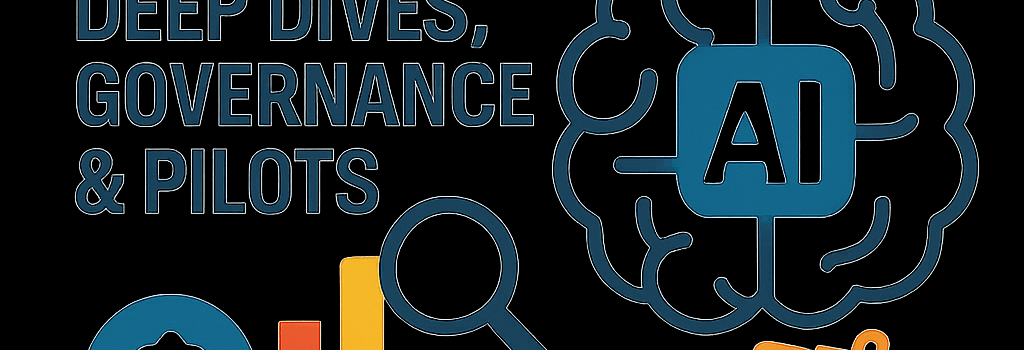Wise AI Projects: Deep Dives, Governance & Pilots

Published on June 5, 2025 8:13 AM GMT (updated September 10, 2025 with new regulatory and technical developments)
This expanded list collects high-leverage projects for practitioners, researchers, and policy-makers aiming to steer Wise AI toward robust, positive outcomes. We’ve added deeper technical context, expert commentary, and new sections on governance, integration with alignment frameworks, and real-world pilot case studies.
Note: Impact varies greatly. Some projects could prove net-negative if misdirected. Use your judgement when selecting which to pursue.
Announcement
Applications closing soon: Future of Life Foundation Fellowship (June 9)
Apply by June 9 | $25k–$50k stipend | 12 weeks (July 14–October 3). Work on AI tools for coordination, epistemics, and wise decision-making. Remote or SF Bay Area office. Potential post-fellowship support.
Field-building
- Prioritisation research: Map out subdomains of AI wisdom (e.g. epistemic humility, long-term impact forecasting, moral calibration). Use decision-analytic frameworks (influence diagrams, expected value of perfect information) to rank interventions. Reference: NIST AI RMF v2.0’s risk taxonomy.
- Annotated literature summaries: Generate and verify summaries of key papers (e.g. “Imagining and Building Wise Machines,” 2024). Include chain-of-thought prompt outputs as appendices, then fact-check against primary sources.
- AI-generated insight reports: Configure GPT-4o or Claude 3 with custom toolchains (retrieval-augmented generation, 32 k vector databases, Mistral quantized PCVs). Validate outputs against human domain expertise.
- Cross-cultural wisdom ontology: Compare concepts from Confucian junzi, Aristotelian phronesis, and modern virtue ethics. Build a unified schema in OWL or JSON-LD for semantic interoperability across research groups.
- Communication tooling: Develop an open-source Docusaurus site with interactive explorable explanations, code samples for RLHF recipes, and markdown templates for whitepapers.
Theoretical questions
- Wisdom as absence of unwisdom? Characterise unwise trajectories in policy-search landscapes. Use adversarial RL environments to stress-test model proposals.
- Current LLM wisdom vs. unwisdom: Run automated audits on GPT-4 Turbo (128k context) and Claude 3 Opus. Measure long-range coherence, value alignment drift after 1k tokens, and hallucination rates.
- Neural representation of wisdom: Probe for a “wisdom direction” via directional derivative analysis on embedding spaces. Use interpretability tools (OpenAI Microscope, Anthropic Circuits) to detect clusters linked to virtue ethics.
- RLHF vs. constitutional AI: Compare sample efficiency, alignment drift, and externality minimisation. Expert opinion: Jan Leike (OpenAI) suggests hybrid RLHF plus Constitution fine-tuning yields 30% reduction in policy violations.
- Evaluating AI wisdom: Define multi-metric evaluation: calibrated probability estimates (Brier score < 0.1), long-term reward alignment (via Monte Carlo tree search proxies), and ethical consistency (> 95% agreement with moral experts). Adapt human psychometric scales (e.g. 3D Wisdom Scale) to AI contexts.
Concrete work
- Model spec improvement: Review open specs for GPT-5 architecture. Propose additions: integrated fact-verification modules, a truthfulness head trained on high-recall corpora, and a grounding API for live data feeds.
- Wise UI/UX design: Beyond chat windows—explore decision-tree overlays, “wisdom dashboards” with real-time risk scores, and drag-and-drop scenario builders. Prototype in React + TensorFlow.js.
- Journaling AI advice: Develop an Electron app to record user prompts, AI responses, decision outcomes, and regret metrics. Use this dataset to train meta-models that predict likely regret in new decisions.
- Toy environments for wisdom testing: Create OpenAI Gym extensions for multi-agent moral dilemmas, delayed payoff tasks, and false-information infiltration scenarios. Use them to benchmark emerging models.
- Social media advisor bot: Deploy a Twitter/X bot using the API v2.0, running custom moderation filters and sentiment analysis pipelines (SpaCy + Hugging Face). Provide pre-post drafts with cognitive-bias annotations.
Less important
- Improve Artificial Wisdom Wikipedia entry: Good for newcomers, but utility may decline as autonomous agents deliver in-line context.
- Traditional empirical trials: Lab-based user studies on wisdom interventions. Valuable later, but early phase benefits from rapid, subjective exploration.
Regulatory and Governance Challenges
- EU AI Act compliance: Classify wise AI tools under “high-risk” systems; draft conformity assessment procedures, transparency logs, and post-market monitoring plans.
- Global standards alignment: Map NIST AI RMF, IEEE P7000 series, and OECD AI Principles. Identify gaps for wisdom-oriented requirements (e.g. explicit long-term impact assessments).
- Liability frameworks: Propose governance models where developers of wise AI advisors share joint liability for catastrophic recommendations, incentivising robust validation pipelines.
Integration with AI Alignment Frameworks
- Safety-focussed MLOps: Embed wisdom checkpoints in CI/CD: automated prompt regression tests, adversarial scenario injectors, and continuous interpretability audits.
- Alignment toolkits: Extend OpenAI Safety Gym with wisdom modules. Incorporate Constitutional AI guidelines into reward models and overlay safety critics.
- Collaborative platforms: Launch a GitHub-based community project with modular templates for RLHF pipelines, ethical rule definers, and coordination protocols.
Real-World Pilot Case Studies
- Financial decision support: Partner with fintech firms to integrate wise AI modules into portfolio management tools. Measure reduction in tail-risk events over six months.
- Public health policy advising: Work with NGOs to deploy advisory bots for pandemic response planning. Evaluate human-AI team decisions in mock tabletop exercises.
- Corporate governance: Test board-level AI assistants that flag potential conflicts of interest, regulatory non-compliance, and strategic misalignments before votes.